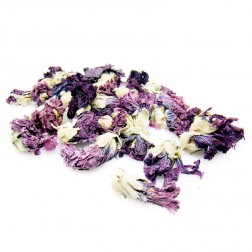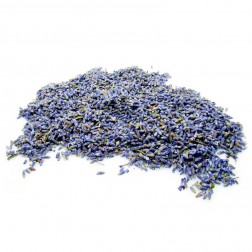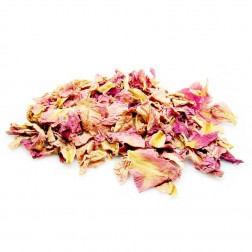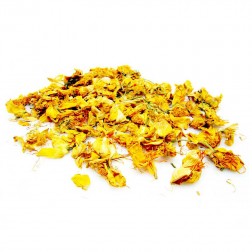Description
Details

Roselle is a thirst quenching tea with vivid-red color. It has a natural lemony sour taste, and is enjoyable served hot or cold. We recommend you to blend it with some honey or ice-sugar unless you are obsessed with the tart fruit flavor.
Also, roselle combines well with fruit juices. Mix it with pineapple juice, orange juice and/or cranberry juice. Sprinkle with lemon slices, and perhaps rum, to make a very summery punch.
Roselle(Hibiscus) has been used in folk medicine as a diuretic and mild laxative, as well as in treating cancer and cardiac and nerve diseases. Although information is limited, the potential for hibiscus use in treating hypertension and cancer, as well as for its lipid-lowering and renal effects, are being investigated.
Scientific Name(s): Hibiscus sabdariffa L. Family: Malvaceae (mallows)
Common Name(s): Hibiscus , Jamaica sorrel , karkade (Egyptian hibiscus tea), karkadi , red sorrel , red tea , rosa de Jamaica , rosella , roselle , soborodo , sour tea , Zobo drink.
Served cold, the tart, grape juice-like drink is most commonly called roselle juice in English. Served hot, it's hibiscus tea or Jamaica tea.
In English-speaking parts of the world, the plant goes by the names hibiscus, roselle, rozelle, Florida cranberry, flor de Jamaica, Jamaica sorrel, Indian sorrel, Guinea sorrel, sorrel, red sorrel, saril, sour-sour, Queensland jelly plant, jelly okra and lemon bush.
In French, it's oseille rouge or oseille de Guinée.
In Spanish, it's quimbombó chino, saril, sereni, rosa de Jamaica, flor de Jamaica, agria, agrio de Guinea, quetmia ácida, viña and viñuela.
In Portuguese, it's vinagreira, azeda de Guiné, cururú azédo, and quiabeiro azédo.
In Surinam, it goes by the Dutch name, zuring.
It's known as bissap in Senegal, krajeap in Thailand, chin baung in Myanmar, and asam paya or asam susur in Malaysia.
In Sudan, Egypt and elsewhere in the Near East, it’s known as karkadé or carcadé.
In Chinese, it's 玫瑰茄 or 洛神花.
Roselle is Neither a Fruit nor a Flower
It’s easy to mistake roselle for a juice in tropical countries because it’s commonly sold streetside and in food courts alongside fresh pineapple, orange, lemon and coconut juices. In Southeast Asian convenience stories, roselle is among the single-serving bottles and juice boxes. It also turns up, as a sherbet, in expensive ice-cream shops. But hibiscus tea has been consumed as a soothing evening tea for centuries in Egypt and elsewhere in the Near East. It probably first made a splash in the prettily-packaged US tea market as an ingredient in Celestial Seasoning’s Red Zinger tea back in the 1970s.
Botanically speaking, it’s Hibiscus sabdariffa L. (family Malvaceae) and it’s the bushy H. sabdariffa var. sabdariffa that produces the edible products.The edible parts used to make “juice” or tea (actually, an infusion) look like reddish dried-up buds. In fact, they’re not flowers but calyces. It’s the calyx, the red, fleshy covering enclosing the flower’s seed pod, which is used for flavoring, cooking and food coloring. The flower of this variety of sabdariffa is yellow, white or light pink.
Roselle(Hibiscus) has been used in folk medicine as a diuretic and mild laxative, as well as in treating cancer and cardiac and nerve diseases. Although information is limited, the potential for hibiscus use in treating hypertension and cancer, as well as for its lipid-lowering and renal effects, are being investigated.
Although roselle is being studied, it hasn’t yet been proven to have the healing powers of bael fruit. It is high in calcium, niacin, riboflavin, vitamin C and iron, as seen on this Purdue University page. And the beverages have no caffeine. In East Africa, “Sudan tea” is consumed as medicine to cure coughs. In Guatamala, roselle is believed to cure hangovers. In Senegal, a roselle extract is said to lower blood pressure. In India, Africa and Central America, infusions made from roselle calyces or seeds are prescribed as a diuretic, to stimulate bile production and to treat fever.
How to Brew?

1. Combine the roselle and water in a large pot and bring to a full boil. Remove from stove and let steep covered for 15 minutes. The color should be a deep red-purple, like some kinds of grape juice.
2. Strain off the liquid through a sieve and throw away the roselle.
3. Stir in lemon juice, ice-sugar, honey (as you like).
4. Serve hot or cold.
After removing the pot from the stove, cooks in Latin America often add a few slices of fresh peeled ginger root. Jamaicans often add rum and ginger to the cold version. In Africa, mint is often added. In Southeast Asia, lemongrass is sometimes added in the boiling stage.
Herbalist doctor's viewpoint
1.Thirst
Hibiscus tea can be drunk hot or cold. As iced tea, the infusion is known to satiate thirst quite effectively. It is often recommended as an alternative to artificially made commercial “sport drinks” that are marketed to physically active individuals. Hibiscus tea’s ability to cool the body is well documented by cultures that include it in their diet or medicinal practices. This benefit is probably associated with the diuretic properties of hibiscus, a property that helps in the excretion of excess fluids from the body.
2.High Blood Pressure
The antihypertensive properties of hibiscus tea were noted by a study in which 70 people were involved; half of them drank hibiscus tea once daily and the other half took 25 mg of antihypertensive medicine twice daily. After a month, 79 percent of the tea drinkers experienced a ten point reduction in blood pressure, 84 percent of the ones that took pharmaceutical medicine also experienced the same reduction in blood pressure. Hibiscus is an antioxidant. It has properties that prevents the oxidation of low-density lipoproteins; a substance in our blood that if increased beyond normal quantities may cause high blood pressure.
3.Weight Loss
Some tea drinkers use hibiscus tea to aid in weight loss. The body produces an enzyme known as amylase which functions to break down complex sugar and starch molecules in food. When a person consumes too much carbohydrate-rich food (full of sugar and starch) that individual is most likely going to gain weight. According to pubmed.gov, hibiscus contains a substance that can inhibit the production of amylase. A person regularly drinking hibiscus tea can thus prevent too much absorption of carbohydrates and consequently not gain excess weight.
4.Cough and Colds
According to the book “Healing Herbal Teas,” fresh hibiscus flowers contain around 6.7 mg of ascorbic acid, a form of vitamin C, which is one of the more essential nutrients needed by the body. Along with this significantly beneficial substance, hibiscus is known to have anti-inflammatory and mild anti-bacterial properties. Thus hibiscus tea is often used as a supplement to help treat coughs and colds. Because of its cooling effect, it is especially effective in reducing the discomfort of fevers that may accompany such ailments.
5.Nutrition
Besides containing a significant amount of ascorbic acid, hibiscus is made of the following nutritional substances: 1.145 g of protein, 2.61 g of fat, 12.0 g of fiber, 1,263 mg of calcium, 273.2 mg of phosphorus, 8.98 mg of iron, 0.029 mg of carotene, 0.117 mg of thiamine, 0.277 mg of riboflavin and 3.765 m of niacin. Given all this, it can be said that hibiscus tea can serve as an excellent food supplement and an aid to boost the body’s immune system.
Additional
Additional Information
| Wholesale Notice | Have a Question about Wholesale? Please check the detailed instruction page here. |
|---|---|
| SKU | ESF-002 |
| Chinese Name | 洛神花(luò shén huā),玫瑰茄(méi guī qié) |
| Other Names | Hibiscus , Jamaica sorrel , karkade (Egyptian hibiscus tea), karkadi , red sorrel , red tea , rosa de Jamaica , rosella , roselle , soborodo , sour tea , Zobo drink, Hibiscus sabdariffa L. ,Malvaceae (mallows) |
| Teaware | Glass Pot, Glass(Tumbler), Piao Yi Tea Maker |
| Water Temperature | 80℃(176℉)~85℃(185℉) |
| Steeping Instructions | Place herbals into the glass pot→Add hot water→Steep for 3-5 minutes(A candle warmer could be used to achieve better results) |
| Storage | Seal tightly, store in a cool, dry place away from sunlight and odour. |
| Country of Manufacture | China |
| Price | $3.90 |
| Packing & Weight | 50g~500g/bag. Default packing with aluminium coated kraft paper bag. |
Reviews
If you have any question concerns about our products or don't find what you need on our site, please contact us via [email protected] and we'll reply soon!






























